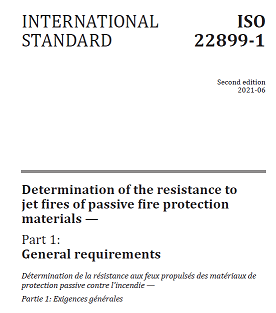ISO 22899-1:2021 Jet Fire被动防护喷射火试验
ISO 22899-1:2021 Determination of the resistance to jet fires of passive fire protection materials — Part 1: General requirements

Introduction
The test procedure described in this document enables the determination of properties of passive fire protection materials. This test is designed to give an indication of how passive fire protection materials are likely to perform in a jet fire. The dimensions of the test specimen can be smaller than typical structure or plant items and the release of gas can be substantially less than that which can occur in a credible event. However, individual thermal and mechanical loads imparted to the passive fire protection material from the jet fire defined in this document have been shown to be similar to those imparted from large-scale jet fires resulting from high-pressure releases of natural gas.
NOTE Guidance on the applicability of the test is intended to be covered in a future part of the ISO 22899 series.
Although the method specified in this document has been designed to simulate certain conditions that occur in an actual jet fire, it cannot reproduce them all exactly and the thermal and mechanical loads do not necessarily coincide. The results of this test do not guarantee safety but may be used as elements of a fire risk assessment for structures or plants. This should also take into account all the other factors that are pertinent to an assessment of the fire hazard for a particular end use. The test is not intended to replace the hydrocarbon fire resistance test (ISO/TR 834-3/EN 1363-2[3]) but is seen as a complementary test.
Users of this document are advised to consider the desirability of third-party certification/inspection/testing of product conformity with this document.
1 Scope
This document describes a method of determining the resistance to jet fires of passive fire protection materials and systems. It gives an indication of how passive fire protection materials behave in a jet fire and provides performance data under the specified conditions.
It does not include an assessment of other properties of the passive fire protection material such as weathering, ageing, shock resistance, impact or explosion resistance, or smoke production.
Complete I-beams and columns cannot be tested to this document due to disruption of the characteristics of the jet.
2 Normative references
The following documents are referred to in the text in such a way that some or all of their content constitutes requirements of this document. For dated references, only the edition cited applies. For undated references, the latest edition of the referenced document (including any amendments) applies.
ISO 834-1:1999, Fire-resistance tests — Elements of building construction — Part 1: General requirements
ISO 13702, Petroleum and natural gas industries — Control and mitigation of fires and explosions on offshore production installations — Requirements and guidelines
3 Terms and definitions
For the purposes of this document, the following terms and definitions apply.
ISO and IEC maintain terminological databases for use in standardization at the following addresses:
— ISO Online browsing platform: available at https://www.iso.org/obp
— IEC Electropedia: available at https://www.electropedia.org/
3.1
assembly
unit or structure composed of a combination of materials or products, or both
3.2
critical temperature
maximum temperature that the equipment, assembly (3.1) or structure to be protected may be allowed to reach
3.3
Delta Tmax
maximum temperature rise (3.18) recorded by any of the installed thermocouples
3.4
fire barrier
separating element that resists the passage of flame and/or heat and/or effluents for a period of time under specified conditions
3.5
fire resistance
ability of an item to fulfil, for a stated period of time, the required stability and/or integrity (3.8) and/or thermal insulation and/or other expected duty, reaching the critical temperature (3.2) specified in a standard fire-resistance test
3.6
fire test
procedure designed to measure or assess the performance of a material, product, structure or system to one or more aspects of fire
3.7
flame re-circulation chamber
mild steel box, open at the front, into which the jet fire (3.10) is directed giving a re-circulating flame resulting in a fireball
Note 1 to entry: Materials other than mild steel may be used when appropriate.
3.8
integrity
ability of a separating element, when exposed to fire on one side, to prevent the passage of flames and hot gases or occurrence of flames on the unexposed side, for a stated period of time in a standard fire resistance (3.5) test
3.9
intermediate-scale test
test performed on an item of medium dimensions
Note 1 to entry: A test performed on an item of which the maximum dimension is between 1 m and 3 m is usually called an intermediate-scale test. This document describes an intermediate-scale jet fire test (3.6).
3.10
jet fire
ignited discharge of propane vapour under pressure
3.11
jet nozzle
orifice from which the flammable material issues
3.12
outside specimen diameter
specimen diameter measured to the outer surface of the passive fire protection (3.13) system on a tubular specimen
3.13
passive fire protection
coating or cladding arrangement or free-standing system that, in the event of fire, provides thermal protection to restrict the rate at which heat is transmitted to the object or area being protected
Note 1 to entry: The term "passive" is used to distinguish the systems tested, including those systems that react chemically, e.g. intumescents, from active systems such as water deluge.
3.14
passive fire protection material
coating or cladding that, in the event of a fire, provides thermal protection to restrict the rate at which heat is transmitted to the object or area being protected
3.15
passive fire protection system
removable jacket or inspection panel, cable transit system, pipe penetration seal (3.16) or other such system that, in the event of a fire, provides thermal protection to restrict the rate at which heat is transmitted to the object or area being protected
3.16
penetration seal
system used to maintain the fire resistance (3.5) of a separating element at the position where there is provision for services to pass through the separating element
3.17
protective chamber
mild steel box, open at the front and back, which is designed to be attached to the rear of the flame re?circulation chamber (3.7) to shield the rear of the flame re-circulation chamber from environmental influences
Note 1 to entry: A protective chamber is not required for tubular section tests but may be used to provide additional stability to the flame re-circulation chamber.
3.18
temperature rise
increase in measured temperature above the initial temperature at a given location
Only informative sections of standards are publicly available. To view the full content, you will need to purchase the standard by clicking on the "Buy" button.
Bibliography
[1] ISO 630-1:2011, Structural steels — Part 1: General technical delivery conditions for hot-rolled products
[2] ISO 13943, Fire safety — Vocabulary
[3] EN 1363-2, Fire resistance tests — Part 2: Alternative and additional procedures
[4] Mather P., Smart R D., Large scale and medium scale jet fire tests, Offshore Technology Report – OTO 97 079, HSE, 1997
[5] British Gas plc, Assessment of the uniformity of the interim jet fire test procedure, Offshore Technology Report OTH 95 477, HSE, ISBN 0-7176-1215-5, 1996
[6] Kay J., Willoughby D., Kerr D., Jet fire tests on a bulkhead pipe penetration seal, PS/06/23, HSE
[7] BS 476-20:1987, Fire resistance test for loadbearing structures, BSI
[8] UL 1709 version 5, 2014 Rapid temperature rise hydrocarbon fire test
ISO 22899-1 Determination of the resistance to jet fires of passive fire protection materials - Part 1: General requirements
ISO 22899-1 被动防火材料的抗喷火的测定.第1部分: 一般要求
ISO 22899-1 and OTI 95634 具体内容可以参考:https://www.fire-test.com/newsinfo/1258674.html
喷射防火测试按照ISO 22899-1要求测定被动消防材料的抗喷射火性能。喷射防火设施模拟可能发生在海上平台和陆上设备的天然气喷射火,在这些海上平台和陆上设备中,天然气外漏可使结构钢曝露到明显热流中。该测试用于认证通常用来保护海上石油平台上钢铁的被动消防材料,并用来模拟高压天然气泄漏引燃和碰撞钢结构的情况。
若要了解喷射防火测试:ISO 22899-1:2021,请与我们联系。
南京睿督公司咨询电话: 025-8658 3475 400-603-6575
网址:www.fire-test.com www.firete.com
邮箱:info@fire-test.com
…








